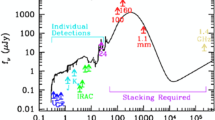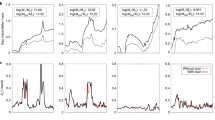Abstract
Galaxy formation is believed to proceed in a ‘bottom up’ manner, starting with the formation of small clumps of gas and stars that then merge hierarchically into giant systems1,2. The baryonic gas loses thermal energy by radiative cooling and falls towards the centres of the new galaxies, while supernovae blow gas out3,4. Any realistic model therefore requires a proper treatment of these processes, but hitherto this has been far from satisfactory5. Here we report a simulation that follows evolution from the earliest stages of galaxy formation through the period of dynamical relaxation, at which point the resulting galaxy is in its final form. The bubble structures of gas revealed in our simulation (for times of less than 3 × 108 years) resemble closely high-redshift Lyman-α emitters6,7. After 109 years, these bodies are dominated by stellar continuum radiation and then resemble the Lyman break galaxies8,9, which are high-redshift star-forming galaxies. At this point, the abundance of elements heavier than helium (‘metallicity’) appears to be solar. After 1.3 × 1010 years, these galaxies resemble present-day ellipticals.




Similar content being viewed by others
References
Blumenthal, G. R., Faber, S. M., Primack, J. R. & Rees, M. J. Formation of galaxies and large-scale structure with cold dark matter. Nature 311, 517–525 (1984)
Springel, V. et al. Simulations of the formation, evolution and clustering of galaxies and quasars. Nature 435, 629–636 (2005)
Mathews, W. G. & Baker, J. C. Galactic winds. Astrophys. J. 170, 241–259 (1971)
Mori, M., Ferrara, A. & Madau, P. Early metal enrichment by pregalactic outflows. II. Three-dimensional simulations of blow-away. Astrophys. J. 571, 40–55 (2002)
Mori, M., Umemura, M. & Ferrara, A. The nature of Lyα blobs: supernova-dominated primordial galaxies. Astrophys. J. 613, L97–L100 (2004)
Dey, A. et al. A galaxy at z = 5.34. Astrophys. J. 498, L93–L97 (1998)
Taniguchi, Y. et al. Lyman α emitters beyond redshift 5: The dawn of galaxy formation. J. Korean Astron. Soc. 36, 123–144 (2003)
Steidel, C. C. et al. Spectroscopic confirmation of a population of normal star-forming galaxies at redshifts z > 3. Astrophys. J. 462, L17–L21 (1996)
Giavalisco, M. Lyman-break galaxies. Annu. Rev. Astron. Astrophys. 40, 579–641 (2002)
Mori, M., Yoshii, Y., Tsujimoto, T. & Nomoto, K. The evolution of dwarf galaxies with star formation in an outward-propagating supershell. Astrophys. J. 478, L21–L24 (1997)
Sommer-Larsen, J., Götz, M. & Portinari, L. Galaxy formation: Cold dark matter, feedback and the Hubble sequence. Astrophys. J. 596, 47–66 (2003)
Matsuda, Y. et al. A SUBARU search for Lyα blobs in and around the protocluster region at redshift z = 3.1. Astron. J. 128, 569–584 (2004)
Taniguchi, Y. et al. The SUBARU Deep Field Project: Lyman α emitters at a redshift of 6.6. Publ. Astron. Soc. Jpn 57, 165–182 (2005)
Haiman, Z., Spaans, M. & Quataert, E. Lyα cooling radiation from high-redshift halos. Astrophys. J. 537, L5–L8 (2000)
Fardal, M. A. et al. Cooling radiation and the Lyα luminosity of forming galaxies. Astrophys. J. 562, 605–617 (2001)
Pettini, M. et al. The rest-frame optical spectra of Lyman break galaxies: star formation, extinction, abundances, and kinematics. Astrophys. J. 554, 981–1000 (2001)
Adelberger, K. L., Steidel, C. C., Shapley, A. E. & Pettini, M. Galaxies and intergalactic matter at redshift z = 3: Overview. Astrophys. J. 584, 45–75 (2003)
Brandt, W. N. et al. The Chandra Deep Field-North Survey. VII. X-ray emission from Lyman break galaxies. Astrophys. J. 558, L5–L9 (2001)
Nandra, K. et al. X-ray properties of Lyman break galaxies in the Hubble Deep Field-North region. Astrophys. J. 576, 625–639 (2002)
Shapley, A. E. et al. Evidence for solar metallicities in massive star-forming galaxies at z∼2. Astrophys. J. 612, 108–121 (2004)
de Vaucouleurs, G. Recherches sur les nébuleuses extragalactiques. Ann. Astrophys. 11, 247–287 (1948)
Mori, M., Yoshii, Y. & Nomoto, K. Dissipative process as a mechanism of differentiating internal structures between dwarf and normal elliptical galaxies in a cold dark matter universe. Astrophys. J. 511, 585–594 (1999)
Bower, R. G., Lucey, J. R. & Ellis, R. S. Precision photometry of early type galaxies in the Coma and Virgo clusters - a test of the universality of the colour / magnitude relation—Part two - analysis. Mon. Not. R. Astron. Soc. 254, 601–613 (1992)
Djorgovski, S. & Davis, M. Fundamental properties of elliptical galaxies. Astrophys. J. 313, 59–68 (1987)
Burstein, D., Bender, R., Faber, S. & Nolthenius, R. Global relationships among the physical properties of stellar systems. Astron. J. 114, 1365–1392 (1997)
Barnes, J. & Efstathiou, G. Angular momentum from tidal torques. Astrophys. J. 319, 575–600 (1987)
Navarro, J. F., Frenk, C. S. & White, S. D. M. A universal density profile from hierarchical clustering. Astrophys. J. 490, 493–508 (1997)
Sutherland, R. S. & Dopita, M. A. Cooling functions for low-density astrophysical plasmas. Astrophys. J. 88 (Suppl.), 253–327 (1993)
Salpeter, E. E. The luminosity function and stellar evolution. Astrophys. J. 121, 161–167 (1955)
Fioc, M. & Rocca-Volmerange, B. PEGASE: a UV to NIR spectral evolution model of galaxies. Application to the calibration of bright galaxy counts. Astron. Astrophys. 326, 950–962 (1997)
Acknowledgements
We thank Y. Matsuda and his collaborators for use of observational data obtained by the Subaru Telescope, and are grateful to M. Rich, M. Malkan, I. Saviane, Y. Yoshii and R. Ellis for suggestions. M.M. thanks the University of California Los Angeles for hospitality, and acknowledges the support of the Japan Society for the Promotion of Science and of the Promotion and Mutual Aid Corporation for Private Schools of Japan. M.U. acknowledges the support of the Ministry of Education, Culture, Sports, Science, and Technology of Japan. The simulations were performed with the Earth Simulator at JAMSTEC, the SPACE at Senshu University, and the computational facilities including CP-PACS at CCS in the University of Tsukuba.
Author information
Authors and Affiliations
Corresponding author
Ethics declarations
Competing interests
Reprints and permissions information is available at npg.nature.com/reprintsandpermissions. The authors declare no competing financial interests.
Supplementary information
Supplementary Methods
This document describes the initial condition of the present model and our dynamical, chemical, and spectrophotometric scheme to explore the formation and evolution of elliptical galaxies including star formation and supernova feedback. (DOC 113 kb)
Supplementary Video 1
This animation visualizes the logarithmic gas density distribution of the simulated galaxy. Simulation box has a physical size of 134 kpc and the number density ranges from 10-4 cm-3 (red) to 1 cm-3 (blue). (MPG 13165 kb)
Rights and permissions
About this article
Cite this article
Mori, M., Umemura, M. The evolution of galaxies from primeval irregulars to present-day ellipticals. Nature 440, 644–647 (2006). https://doi.org/10.1038/nature04553
Received:
Accepted:
Issue Date:
DOI: https://doi.org/10.1038/nature04553
- Springer Nature Limited
This article is cited by
-
A simple approach to the high-redshift sub-millimeter galaxies
Astrophysics and Space Science (2010)
-
Astrophysics in 2006
Space Science Reviews (2007)
-
Galactic winds from primeval galaxies
Astrophysics and Space Science (2007)
-
Rags-to-riches galaxies
Nature Physics (2006)





